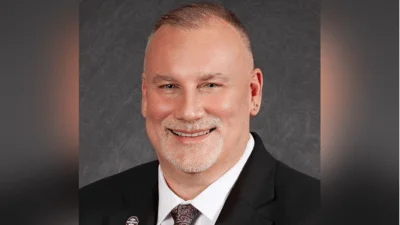Upon meeting in the parking lot of the Saber and Quill, Mr. John Campbell gave a brief introduction for the day and then the Leadership Team divided themselves into two groups (Team Blue Van and Team Red Van) for a driving tour of Ft. Knox. On the tour, John Campbell, driver of the red van pointed out base housing, schools, parks, and other notable sites. All this information was relayed to SGT King, driver of the blue van and his occupants through the use of military grade super top secret technology. Just kidding, we just used cell phones.
After the driving tour, the class headed to the Army Reserve Aviation Command. The Leadership Team had the opportunity to meet Major Hall, one of the Blackhawk pilots stationed at Ft. Knox. He described the US Army’s Blackhawk helicopter and compared its mission and capabilities to the Apache helicopter. He described several pathways to become a helicopter pilot in the Army and career options after military service. He also gave us the heroic history of the Flying Tigers squadron.
The class really appreciated climbing into the Blackhawk but noticed they didn’t leave the keys around and the US Army squadron kept it attached to the tow truck so we could not take it for a spin. There were lots of buttons and levers, and the Leaders had to exercise an abundance of self-restraint to keep from pushing/pulling them all.
Our next stop was to visit the Military Working Dogs on Fort Knox. We were greeted by Staff Sergeant Strick and their mascot, an adorable German shepherd puppy appropriately named Bourbon. SSG Strick explained that the majority of military working dogs are born in Europe and begin training around age two. The training is approximately six months. They are trained to detect explosives or drugs but not both. Once training is completed, they are sent to their command where they meet their handler. Each military working dog works exclusively with one handler. The handler is responsible for daily care and training for their four-legged partner.
All interactions are documented in explicit detail in the working dog’s record. When units are deploying and need the skills of these soldiers, they review the training records to choose the working dog best equipped to meet the needs. When the working dog is deployed for a mission, the handler accompanies him or her. Usually a military working dog retires after eight or nine years of service. He or she can then be adopted by the current handler or a previous handler.If the dog cannot be adopted out internally, the public can have the opportunity to adopt, so there may be some future retired military working dog owners in our midst.
The highlight of the day for many of the Leadership Team were all the cuddles and kisses from Bourbon.
We were a little less willing to cuddle with Dollar after the demonstration he and Specialist Riley gave to the class. Upon Specialist Riley’s command, the training “perpetrator” was attacked by Dollar as he tried to run.Dollar launched himself at the unfortunate “perp” and latched on to his arm until he was on the ground and obeying SPC Riley’s commands. Thank goodness for that bulky training suit because Dollar would do some major damage without it.SSG Strick explained that Dollar is trained to search for drugs and that he can hit the perpetrator at about 30 mph at full speed. No one on the leadership Team was willing to put on the training suit to get rolled and pinned down by Dollar.
The Leadership Team followed that visit with lunch at Samuel Adams Brewhouse on post. While we enjoyed our burgers, chicken tenders, and salads, we met the Garrison Commander COL Lance A. O’Bryan and Deputy Garrison Commander, Jim M. Bradford. They shared the importance of Hardin County (as well as other surrounding counties and communities) to the growth of the post and support of the service members stationed here. They explained the importance of the ranges for training of elite forces and other units in the Army and other branches of the US military. Additionally, they highlighted the things that make Fort Knox and the surrounding communities so special. Did you know that Fort Knox can operate completely “off the grid”? Non-military community members are encouraged to come on post to enjoy all that Fort Knox has to offer, such as a golf course, water park, indoor swimming pool, hunting and fishing. COL O’Bryan and Mr. Bradford advised to enter post the right way, by getting a visitor’s pass (which is good for one year). They told the Leadership Team that Fort Knox is constantly being looked at by units and other Department of the Army entities looking to relocate.
Our final stop was the Bluegrass ChalleNGe Academy. We visited with the school, which is one of two programs in the state dedicated to creating a positive change in the lives of at-risk youth. While the residential program uses a quasi-military format to instill positive leadership and followership in the cadets, it is not part of the Department of the Army or Fort Knox. It is a part of Eminence Independent School District in which cadets spend 22 weeks working toward academic excellence (they are earning their high school credits), community service, and responsible citizenship. They obtain physical fitness, job skills and life coping skills during their residential time but continue mentorship for at least a year following graduation. This provides opportunities for scholarships after completing the entire program. We also toured the facility with three current cadets as the explained a typical day (which begins with physical training around 5:30am).
We also learned of the need for mentors for these young people. Mentors play a vital role in providing support to cadets for the year after they transition out of the program. What an amazing opportunity to learn about Fort Knox!
Original source can be found here.






 Alerts Sign-up
Alerts Sign-up